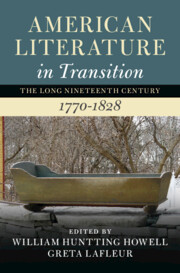Book contents
- American Literature in Transition, 1770–1828
- Nineteenth-Century American Literature In Transition
- American Literature in Transition, 1770–1828
- Copyright page
- Contents
- Contributors
- Series Preface
- Acknowledgments
- Chapter 1 Introduction
- Part I Form and Genre
- Part II Networks
- Part III Methods for Living
- Chapter 14 The Affective Postwar
- Chapter 15 Revolutionary Lives
- Chapter 16 Literature of Poverty and Labor
- Chapter 17 Neuroqueering the Republic
- Chapter 18 A Queer Crip Method for Early American Studies
- Index
Chapter 18 - A Queer Crip Method for Early American Studies
from Part III - Methods for Living
Published online by Cambridge University Press: 09 June 2022
- American Literature in Transition, 1770–1828
- Nineteenth-Century American Literature In Transition
- American Literature in Transition, 1770–1828
- Copyright page
- Contents
- Contributors
- Series Preface
- Acknowledgments
- Chapter 1 Introduction
- Part I Form and Genre
- Part II Networks
- Part III Methods for Living
- Chapter 14 The Affective Postwar
- Chapter 15 Revolutionary Lives
- Chapter 16 Literature of Poverty and Labor
- Chapter 17 Neuroqueering the Republic
- Chapter 18 A Queer Crip Method for Early American Studies
- Index
Summary
What do Deborah Sampson/Robert Shurtliff, Charity Bryant, Sylvia Drake, and Fitz-Greene Halleck all share in common? Each illustrates the need for a queer crip method in early American studies. Too often, disciplinary conventions have isolated the queer past from disability history. Stories of gender variance and sexual difference have deployed ableist rhetorics to legitimize recuperation. Meanwhile, histories of disability have highlighted the way preindustrial divisions of labor led families to make accommodations for disabilities without challenging heterosexist suppositions about what counts as kinship. This chapter examines the discursive tools of self-fashioning, erotic built interiors, and sensorial aesthetics that early national figures harnessed to compose queer disabled livelihoods. In a reconsideration of the focus on (de)pathologization in queer theory and disability studies, I propose a method attuned to sites of microhistorical transition, where queer disabled embodiment permitted a tailoring of one’s world to identities, intimacies, and forms of communication otherwise unattainable.
Keywords
- Type
- Chapter
- Information
- American Literature in Transition, 1770–1828 , pp. 327 - 352Publisher: Cambridge University PressPrint publication year: 2022

